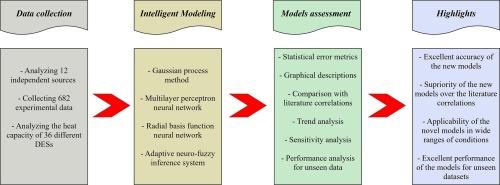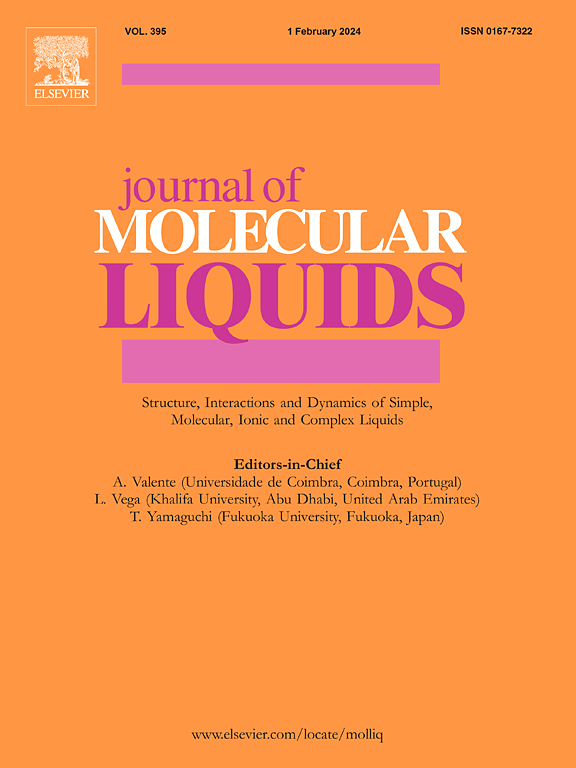Comprehensive models to estimate the Isobaric heat capacity of deep eutectic solvents based on Machine learning algorithms
IF 5.3
2区 化学
Q2 CHEMISTRY, PHYSICAL
引用次数: 0
Abstract
Deep eutectic solvents (DESs) have recently gained significant attention due to their sustainable and environmentally friendly properties. Acquiring exact knowledge regarding the isobaric heat capacity (Cp) of DESs is essential for energy-related processes, in which these green solvents are utilized. Hence, this study deals with the development of comprehensive models for estimating the Cp of DESs. To reach this target, 682 experimental data, encompassing the Cp of 36 different DESs over widespread ranges of pressure and temperature, were assembled from the literature. The foregoing data were employed to establish new models based on four machine learning techniques, including Gaussian process method (GPM), Adaptive neuro-fuzzy inference system (ANFIS), Radial basis function neural network (RBF-NN) and Multilayer perceptron neural network (MLP-NN). The evaluations performed based on the statistical indices and graphical tools demonstrated that although all suggested models present excellent estimations, that designed based on the MLP-NN method yields the highest accuracy with Mean absolute percentage error (MAPE) and coefficient of determination (R2) values being 0.4% and 99.93, respectively, for the validation data. A comparison between the results of the literature correlations and those of novel models confirmed the obvious superiority of the latter. Moreover, the proposed models properly described the Cp variations of different DESs versus pressure and temperature. The order of importance of various factors in controlling the Cp of DESs was also determined based on the sensitivity analysis. Eventually, the intelligent models showed excellent performance in estimating the Cp of unseen DESs.

基于机器学习算法估算深共晶溶剂等压热容的综合模型
深共晶溶剂(DES)因其可持续和环境友好的特性,最近受到了广泛关注。获得有关 DESs 等压热容 (Cp) 的准确知识对于使用这些绿色溶剂的能源相关过程至关重要。因此,本研究涉及开发用于估算 DESs Cp 的综合模型。为了实现这一目标,我们从文献中收集了 682 个实验数据,其中包括 36 种不同 DES 在不同压力和温度范围内的 Cp。利用上述数据建立了基于四种机器学习技术的新模型,包括高斯过程法(GPM)、自适应神经模糊推理系统(ANFIS)、径向基函数神经网络(RBF-NN)和多层感知器神经网络(MLP-NN)。根据统计指数和图形工具进行的评估表明,尽管所有建议的模型都能提供出色的估算结果,但基于 MLP-NN 方法设计的模型准确度最高,验证数据的平均绝对百分比误差(MAPE)和判定系数(R2)值分别为 0.4% 和 99.93。通过比较文献相关性和新模型的结果,证实了后者的明显优越性。此外,所提出的模型恰当地描述了不同 DES 的 Cp 随压力和温度的变化。根据敏感性分析,还确定了控制 DES Cp 的各种因素的重要性顺序。最终,智能模型在估算未见过的 DES 的 Cp 方面表现出色。
本文章由计算机程序翻译,如有差异,请以英文原文为准。
求助全文
约1分钟内获得全文
求助全文
来源期刊

Journal of Molecular Liquids
化学-物理:原子、分子和化学物理
CiteScore
10.30
自引率
16.70%
发文量
2597
审稿时长
78 days
期刊介绍:
The journal includes papers in the following areas:
– Simple organic liquids and mixtures
– Ionic liquids
– Surfactant solutions (including micelles and vesicles) and liquid interfaces
– Colloidal solutions and nanoparticles
– Thermotropic and lyotropic liquid crystals
– Ferrofluids
– Water, aqueous solutions and other hydrogen-bonded liquids
– Lubricants, polymer solutions and melts
– Molten metals and salts
– Phase transitions and critical phenomena in liquids and confined fluids
– Self assembly in complex liquids.– Biomolecules in solution
The emphasis is on the molecular (or microscopic) understanding of particular liquids or liquid systems, especially concerning structure, dynamics and intermolecular forces. The experimental techniques used may include:
– Conventional spectroscopy (mid-IR and far-IR, Raman, NMR, etc.)
– Non-linear optics and time resolved spectroscopy (psec, fsec, asec, ISRS, etc.)
– Light scattering (Rayleigh, Brillouin, PCS, etc.)
– Dielectric relaxation
– X-ray and neutron scattering and diffraction.
Experimental studies, computer simulations (MD or MC) and analytical theory will be considered for publication; papers just reporting experimental results that do not contribute to the understanding of the fundamentals of molecular and ionic liquids will not be accepted. Only papers of a non-routine nature and advancing the field will be considered for publication.
 求助内容:
求助内容: 应助结果提醒方式:
应助结果提醒方式:


